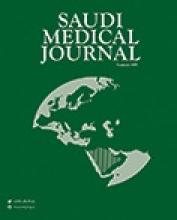Abstract
OBJECTIVE: To estimate the prevalence of chronic venous insufficiency (CVI) in the Saudi adult population and to identify the association of CVI with possible risk factors.
METHODS: Sixteen Primary Health Care (PHC) centers have been randomly selected in various districts of 3 major cities of Kingdom of Saudi Arabia, including Jeddah, Makkah and Dammam during the year 2001. Every Saudi patient, of both sexes and aged >18 years, visiting the selected PHC centres for any reason, was eligible. The study was conducted during 6 consecutive days. Patients' history, demographics and risk factors were recorded and clinical examination was performed in order to diagnose CVI according to the latest clinical severity, etiology or cause, anatomy, pathophysiology (CEAP) classification.
RESULTS: A total of 2566 participants were recruited. Out of these, 2350 were included. Fifty-three percent of the included patients were females and 66% were from the Western region. The overall prevalence of CVI (from class 0 to 4) was 45.6% (95% confidence interval [CI] 43.6 - 47.6). Considering CVI with visible signs only (class 1 to 6), the prevalence was 38.3% (95% CI 36.6 - 40.2). It was found higher in female (49.6%) and in the Western region (43.0%). Chronic venous insufficiency was significantly associated with age, family history of CVI, prolonged standing occupation and the use of hormonal therapy.
CONCLUSION: These data demonstrated a high prevalence of CVI in the Saudi population, which is higher than in Western countries, especially in the Western region. This is probably linked to the high frequency of risk factors in the Saudi population and to the current lifestyle.
- Copyright: © Saudi Medical Journal
This is an open-access article distributed under the terms of the Creative Commons Attribution-Noncommercial-Share Alike 3.0 Unported, which permits unrestricted use, distribution, and reproduction in any medium, provided the original work is properly cited.






